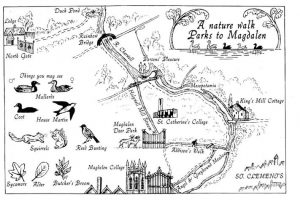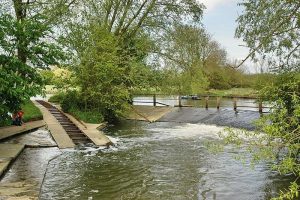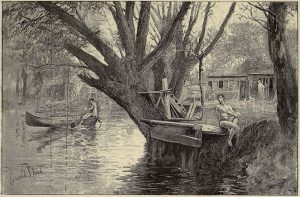Parson’s Pleasure v.s. Dame’s Delight
 7 min read
7 min readWhere can a lady get a dip around here?
Both Parson’s Pleasure and Dame’s Delight are two now-defunct bathing places, opposite of the land strip known as ‘Mesopotamia’, a term of Greek etymology meaning ‘land between two rivers’, which is also used to refer to an area between the rivers Tigris and Euphrates in modern-day Iraq.

A nature walk Parks to Magdalen – Mary Potter (source: Daily Info)
This strip of land was purchased by the University of Oxford as part of an expansion of the University Parks, which occurred between 1860 and 1865. Before the early 1800s, Parson’s Pleasure, otherwise known as Paten’s Pleasure and Loggerhead in the 17th and 19th centuries respectively, was deemed by locals as an ‘open’ bathing place, available to all. However, it should be noted that throughout the duration of its operation, it was mostly used as a nude bathing place for men.
In 1865 wooden screens were erected to enclose Parson’s Pleasure as a result of a new footpath being introduced, linking South Parks Road to the parish of St. Clements, which would have increased the risk of indecency as the number of daily passers-by surged due to the footpath’s connection to the city. Though it was previously commercialised in the 1830s, Parson’s Pleasure became more and more select nearing the end of the 19th century, mostly due to its high entry fees. Though public access was considered, the bathing place was only open to members of the university and their families and friends between 1874 and 1890s. However, by the turn of the century it became widely used by the public, especially in the summer, partially propagated by the boating craze of the 1890s, when rollers were built at Parson’s Pleasure to facilitate pushing boats into the river Cherwell.

The weir and punt rollers at Parson’s Pleasure
Toby Thurston, 2005
It was not only men who followed this craze at the time, as punting came to be considered a suitable pursuit for women. Furthermore, bathing culture itself, which was largely limited to bathing at bathhouses for women on certain days and times, was shifting towards public bathing and swimming. It was at this time that Parson’s Pleasure underwent some drastic changes. It became clear that the screens that were built were no longer able to seclude the bathers in Parson’s Pleasure away from the rest of the crowd enjoying the Cherwell.
As a response to the area becoming frequented by the public, and especially women passing through the bathing place, two regulations were put forth in 1887 by the Curators. The first of the two pertained to women being forbidden to pass through Parson’s Pleasure, having to disembark upon its entrance and then rejoining their boats at the other end, while the second instructed all who used the roller ways to follow the directions of the Parks attendant. A footpath was added shortly after, referred to as the ‘ladies path’, which was designed to wind around the outside of the screens, that women were made to take; disembarking, walking along the path and then and re-embarking on the boats. This was protested from the 1960s or even earlier by women punters and passengers, some of whom refused to comply with the regulations.
At the same time, more attention was brought to the lack of spaces where women could engage with outdoor bathing and swimming. Women were eventually allowed access to Parson’s Pleasure between 1891 and 1898 to take daily swimming classes or bathe casually (if they already knew how to swim), between 1 and 2pm or from August 1st to August 12th. In 1898, a bathing place for women only was established upstream of Parson’s Pleasure on the island known as Isle or Rhea or ‘the Rhea’, which marked the end of women’s access to Parson’s Pleasure. And then, in Spring of 1934, another bathing place much closer to Parson’s Pleasure, was organised by the university known as Dame’s Delight.
It was initially requested by women students to be supervised by a trained woman attendant, that nude bathing should be allowed if desired, and that men were not permitted inside. This was shot down by the secretary of the Curators of the Parks, deeming the presence of a male attendant as ‘necessary’. A male attendant was appointed, but a woman-student organized petition enabled the appointment to the position of Royal Life Saving Society certified P.M. Barwise, a woman. However, she was replaced in 1936, following the drowning of Francis John Miller, where Barwise could not intervene because she was recovering from an operation. When Barwise was replaced, a male attendant took her place in 1936, which put an end to nude bathing at Dame’s Delight. This and the presence of mixed-gender children gave this bathing place a very different character than its men-only counterpart.
Parson’s Pleasure, in contrast to Dame’s Delight, was to remain an exclusive space for men, solidifying the division between men and women, bolstered by its enclosure with screens, and in spite of norms shifting away from male-dominated bathing culture and more broadly becoming more accepting towards female presence into academia. Bathing at Dame’s Delight came to an end in 1969, when maintenance became difficult due to serious flooding and the Curators opted not to make the necessary repairs to keep it open. This, however, did not result in Parson’s Pleasure being re-opened up for women, even though calls were being made for allowance of mixed-sex bathing, not even with the introduction of the Sex Discrimination Act of 1975, as the Curators believed that Parson’s Pleasure to fall under the provision that:
‘it is not unlawful to restrict facilities to one sex if the nature of the facilities and services is such that male users are likely to suffer serious embarrassment if women are present (or vice versa) or if the users are likely to be undressed.’

Parson’s Pleasure in the late nineteenth century, drawn by Lancelot Speed, from Aspects of Modern Oxford, by a Mere Don [A. D. Godley] (New York: Macmillan & Co, 1894)
Written and researched by MOX volunteer Iulia Costache
Want to write your own Oxford-inspired post? Sign up as a volunteer blogger.
Bibliography:
Nature walks. (n.d.). Retrieved from https://www.dailyinfo.co.uk/guide/oxford-cartoonist/nature-walks
Ross. (2020). Retrieved from https://queeroxford.info/2017/09/24/parsons-pleasure/
Townsend, George Jack Nairne (2022) A cultural history of Parson’s Pleasure. [Thesis] (Unpublished)
Copyright
© Oxford University
